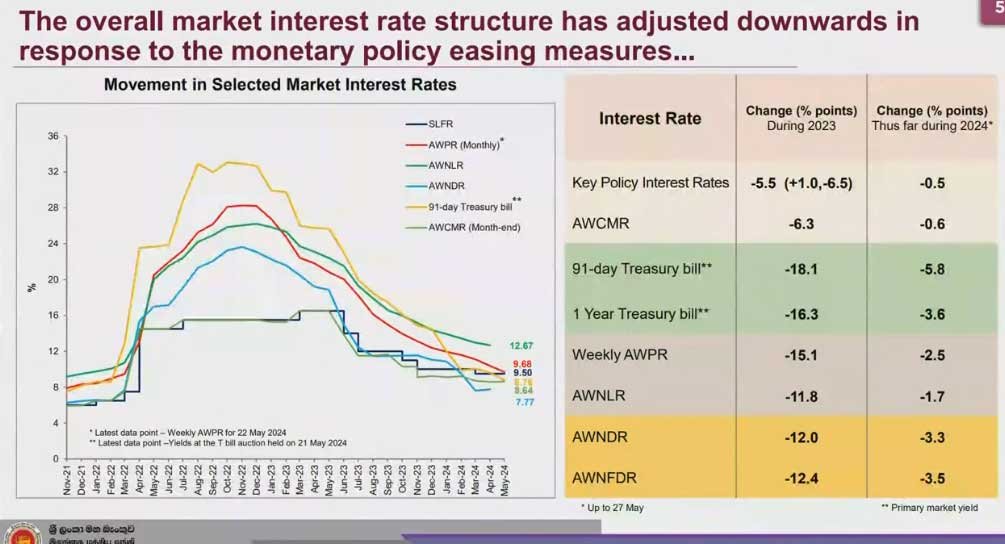
ECONMYNEXT – Sri Lanka’s retail sales are picking up and private credit is expected to follow in the second half of the year if business begin investing for expansion, Central Bank Governor Nandalal Weerasinghe said.
Though private credit is positive it is still ‘sluggish’ central bank said.
At the moment working capital is being borrowed.
Credit Demand
Businesses are trying to de-leverage after a currency crisis, and also re-negotiate old loans with lower interest rates as complaints from the SME sector shows.
De-leveraging is part of a credit cycles that improves the balance sheets of business across the board and leaves them in a stronger position to expand in the future.
To expand however retail sales has to pick up. Capital investments then start as existing capacity or slack runs out and there is more confidence in the future.
“We have seen retail sales picking up in the recent past,” Governor Weerasinghe said. “I think that will push up some of the SME borrowings in the coming months.”
Early indications show that credit has not moved fast in April, he said.
“Hopefully in the months of May and June credit will pick up.”
The Prime Lending Rate has started to fall, indicating the risk appetite.
“Volumes are also rising,” Governor Weerasinghe told reporters after the latest monetary policy decision to hold rates.
“But businesses are still not willing to borrow on a longer term.”
Sri Lanka’s central bank has kept inflation low and allowed the exchange rate to appreciate in the first quarter which had brought down price of many imported goods which could also help drive up retail sales.
A stronger exchange rate would also reduce building material prices, which may reduce the overall need for capital investments or allow bigger projects in the future, compared to a 370 to the dollar exchange rate that was seen in 2022.
Sri Lanka periodically hikes rates steeply to avert currency crises, which are usually triggered by cutting rates with inflationary open market operations and standing facilities on the basis of 12-month historical inflation data without regard to current credit conditions at the time, critics say.
This year rates have fallen due to weaker private credit, strong finances of the state enterprises, which allows debt repayments, a flattening state deficit by tax hikes as well as confidence and stability created by the central bank which halted capital flight.
But there is also reserve collection (financing the budget deficits of foreign countries) under an IMF program and repaying central bank swaps.
A slower fall in rates has been observed compared to an initial response to hikes in earlier cycles as well Governor Weerasinge said.
Abnormal Cycle
“If you look at the charts it has been coming down significantly, but still no aligned with policy rates, under normal monetary policy cycles,” Governor Weerasinghe told reporters.
“In a cycle of policy easing transmission happens with a time lag.”
This time is not a normal cycle with debt restructuring added to the mix.
In Ghana which also has flexible inflation target at 8.0 percent, a default, depreciation and debt restructuring has seen instability continue with a gilt market shock from wide domestic debt restructuring.
In Ghana the policy rate is 29 percent, inflation 25 percent and the 3-month bill 23 percent in May.
Sri Lanka has also hiked income taxes. Unlike value added tax, where money is collected after transactions, including retail sales, income tax kills the disposal income required to make transactions happen.
Legislators led by the Justice Minister lifted the parate execution, or foreclosure, in a sudden state intervention, which banks had already warned would make them more cautions in lending to good customers.
It is not clear to what extent the parate execution suspension is contributing to sticky new lending rates and delaying an economic recovery.
Classical economists refers to such shocks as ‘regime uncertainty’. In the US during the extension of the Great Depression and delay in investment spending was directly attributed to state interventions especially under the New Deal, which spooked investors.
Confidence created by the central bank through recent exchange stability and virtually no inflation amid falling import prices, which could trigger a similar fall in domestic substitutes, may also increase disposable income, initially allowing more reserves to be collected and deposit rates to fall.
The latest dollar purchases however been left mostly unsterilized, allowing excess liquidity build up, which analysts say may will push rates down, particularly deposit rates, but may pressure the exchange rate unless mopped up to some extent or the exchange rate defended to lose the liquidity and reserves as credit demand resumes.
Governor Weerasinghe said there was a claim that banks had raised deposit rates (most fixed deposits are up to one year in Sri Lanka) but that re-pricing had now largely happened.
New lending
Though negotiations for old loans may be going on, which also depends on bargaining between banks and customers, Governor Weerasinghe said he would like to seen new lending rates falling faster.
“We are monitoring the new lending rates, which are around 12.5 percent it is till the highest,” Governor Weerasinghe said.
“We are emphasizing that new lending should happen at closer to the other market rates.”
There are some new apartment projects and land sales are also being advertised
Credit growth depending on actual credit demand.
Governor Weerasinghe pointed out that the ban on car imports could also contribute to a slower credit.
Vehicles are financed by both banks and leasing companies. Leasing companies themselves have credit lines with banks.
